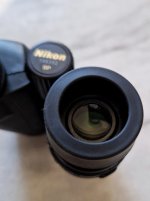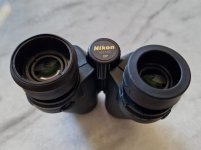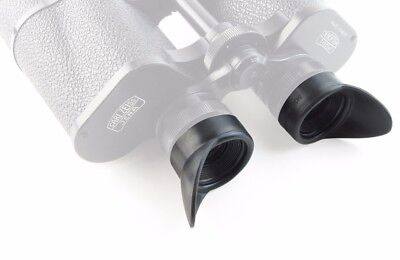Let’s talk about eyecups (comfort, dimensions, preferences, etc.)
When reading binoculars reviews and experiences you hear a lot about the optical performance of a certain device and also about its physical aspect: usually the dimensions and in particular how the focus wheel works (whether it’s fast or slow, soft or grainy, etc.) and also a mention about the eyecups. But I find that mostly eyecups are dealt with in terms of eye relief expressed in mm (which is of course relevant for spectacle wearers). This is all correct. However, I think little attention is put on the design, dimensions and shape of the eyecups, except for the odd case where eyecups are on an extreme (enormous, really clunky, too small, too hard, etc.).
If I was to compare binoculars with bicycles (to give an example helping me make my point), both are devices formed by many parts, but where the user has only a couple of direct contact points with the tool itself. In a bicycle, the saddle is a really important bit of the bike, as it can completely ruin your experience, even if you’re riding a 10.000 € bike. As an avid cyclist, in my personal experience, a similar thing can be said about eyecups. I know many will disagree (and that’s what a forum is all about), while there will probably be some for whom eyecups have never been worth a particular attention. After all, we are all different. I recall reading several times in this forum how a focus wheel that focus counter clockwise to infinity is simply a deal-breaker for some forum members, while for me that’s just a no-problem. I don’t mind which way the focus wheel turns as long as it works properly (soft, no play). But I’m really curious to know the experience, preferences and dislikes of forum members regarding this issue.
Over the course of the last 6 years of so I must have bought/sold/owned/tried more than 100 binoculars and have come to appreciate some of its characteristics and something keeps coming back. Some models that get a great deal of praise (and for good reason) just don’t work for me… and after giving it a thought, in many notable cases it was simply the narrow eyecups. I can think of the Meopta Meostar 8x32, Swarovski Habicht 8x30 (the green ones improved the experience), Swarovski CL Companion 8x30 (new), Leica “Retrovid” 7x35 to name a few. Lately I’ve started the quest to find some nice pocket binoculars and have experienced how finicky eye position is and how little user-friendly some models are, even very good an expensive ones. But, alas, the other day (what finally sparkled this thread) I tried a very compact 7x20 (the old Nikon CF III) where things were different: eye confort was good, and the use, even for extended periods of time, was almost like that of a regular size device. When I measured the eyecups, the mystery was unveiled, they share the same inner diameter dimensions a my much loved Swarovski EL SV 8x32, and on full size binoculars territory, nearly like a 7x42 Zeiss Victory FL. My experience with this 7x20 is that what makes eye position finicky is not that much the 3 mm exit pupil (my 12x36 Canon IS work fine with that), but the narrow eyecups. To add insult to injury, many compact 8x20 - 8x24 with narrow exit pupils also share a dual hinge design and a tiny focus wheel, which makes using them a bit of a chore. So, out of curiosity I’ve measured the eyecups of some binoculars I have at hand (inner diameter; a +- 1 mm error is fully possible). In this list (-) means “probably a tad less” and (+) the opposite.
Inner diameter of the eyecups of some binoculars, measured in mm
Leica Ultravid 8x20: 20 mm (-)
Swarovski Habicht 8x20: 21 mm (+)
Zeiss Terra 8x24: 23 mm
Leica “Retrovid” 7x35: 24 mm
Opticron Traveller BGA ED 8x32: 27+ mm
Kowa YF 8x30: 27 mm
Vixen New Foresta HR 8x56 WP: 29 mm
Swarovski EL SV 8x32: 31 mm
Nikon CF III 7x21: 31 mm
Zeiss Victory FL 7x42*: 32 mm
Nikon A (Gold Sentinel) 7x35: 35 mm
Canon IS III 12x36: 35 mm (+)
Vortex Diamondback HD 8x32: 25/36 mm (they have a "double rim" design)
Nikon EII 8x30: 38 mm
Some interesting surprises. As stated before, the tiny 7x20 Nikon CF III shares the eyecup inner diameter of a Swarovski EL SV 8x32, and nearly that of a full sized Zeiss Victory FL 7x42… and it’s bigger than those of a huge Vixen New Foresta 8x56!
Looking back at some pictures I took of the Leica “Retrovid” 7x35 I discovered that they nearly share the same inner diameter of the pocket 8x25 Zeiss Terra ED, which I found too narrow an uncomfortable for a “big” pocket binocular (with little advantage over some compact 8x32). I'm pretty sure we all have a wide array of facial features, nose size/structure and preferences, so this can be fun. And, well, obviously bigger is not always better, I remember the eyecups of the Vixen Foresta (porro) 8x32 and 7x50, those where so big and chunky that I found them to be just too big (like in "not particularly comfortable).
So, what are your thoughts and experiences? I remember reading some forum members who prefer the old style rubber fold down design, since it is less likely to catch sand/dust/debris in hard conditions, like twist-up can. Some other bulk up their narrow eyecups with tyre rubber, etc... I'm guessing many spectacle wearers won't have as much issues as non-users, because they don't actually have direct contact with the eyecups (if you do comment, it could be interesting to note if you use glasses or not). So many preferences for something that gets less attention than it should.
Why not demanding binoculars with 2 or 3 different sets of eyecups?
A final thought. While using the Swarovski Habicht 8x30 and being frustrated by the narrow eyecups, I remember following the advice of getting the eyecups of the green rubber armoured version, those happened to be wider and screw in perfectly in the faux leatherette black version. So, here’s a thing: as a matter of fact, the Swarovski Habicht has 2 different “sizes” of eyecups, narrow and wide. I find it at least plausible that manufacturers could include (or at least offer as an option) 2 or 3 different sets of eyecups, the same way you get earphones with 3 silicone plugs of different sizes, or the same way some shoe manufacturers offer 2 or 3 different width of the same size. Obviously not in an entry level 150 € pair of binoculars, but I don’t think it’s crazy to demand such a thing in a 1500 - 2500 € top of the line binoculars from brands such as Zeiss, Swarovksi, Leica, etc. that include every known sophistication. Since they all have unscrewable/replaceable eyecups, I think it could be done. After all, the little Habicht shows its possible.
(Sorry for the lengthy post, I think it’s an interesting subject that’s widely overlooked)











